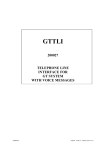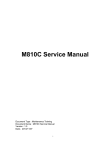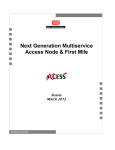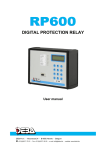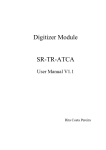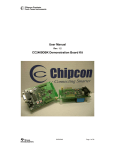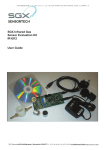Download UMA1015AM Low Voltage Dual Synthesiser
Transcript
USER MANUAL UMA1015AM Low Voltage Dual Synthesiser CTT/97001 Guidance to Assembly and Operation Preliminary Technical Report Pascal Hugues Technical Marketing Telecommunication IC’s Caen, France Date: May 23rd, 1997 Philips Semiconductors Philips Semiconductors UMA1015AM Dual Frequency Synthesizer User Manual 1. Differences with the UMA1015M Last Version • The minimum digital and charge pump supply voltages are 2.7 V (VCC ≥ VDD). It was 2.6 V when using the UMA1015M. • For the 400 to 1100 MHz RF frequency range, the minimum RF input signal voltage is 50 mV rms, for the complete supply range. With the UMA1015M, the minimum RF input level is 100 mV rms when the digital supply is greater than 3.5 V. • The operating ambient temperature range is -30°C to +85°C for both synthesisers. For the UMA1015M, it was 0 to +85°C with the synthesiser B supplied by a digital voltage greater than 4.5 V. • The common reference divider can be driven by a simple quartz since an internal oscillator / buffer is designed on the UMA1015AM. With the UMA1015M, it was just possible to use the VTCXO. A register (address 1000 ; bit p15) was added to keep this internal oscillator / buffer ON when both synthesisers are in power down if desired. After the supply voltage is switched on, the bit p15 (address 1000) is preset to 0. • A solution has been implemented with the UMA1015AM design which permits to have independent synchronisation for both synthesisers. So, if one synthesiser is in power down condition, then when it is reactived, the main divider will synchronise with the reference divider in such a way as to avoid large random phase errors at the phase comparator, independent of the state of the other synthesiser (power up or power down). With the UMA1015M, when one synthesiser is already in power up, and the second is powered up, it restarts with a random phase error at the phase comparator. • When the UMA1015AM is turned off, the phase detectors of A or B synthesisers are synchronised with the charge pumps. This avoids powering down the synthesisers whilst they are sinking or sourcing current pulses to the loop filter. • For the UMA1015AM, the out-of-lock condition is flagged for a phase error greater than approximately 15ns and is released after the first cycle with a phase error less than 25ns. For the UMA1015M, the out-of-lock condition is flagged when the phase error is greater than 80 cycles of the relevant RF input (TOOL). The out-of-lock flag is only released after the eight reference cycles where the phase error is less than TOOL. • The minimum RF input frequency is 45MHz with a input level higher than 0dBm. For the UMA1015M, the minimum input frequency is 50MHz. As the UMA1015AM is pin to pin and software compatible with the UMA1015M, it is expected that the latter can be replaced in your application by the UMA1015AM without modification. 2 Philips Semiconductors UMA1015AM Dual Frequency Synthesizer User Manual 2. Guidance to Assembly and Operation 2.1. Introduction The UMA1015AM is a low power low voltage single chip solution to a dual frequency synthesiser used in radiocommunications. Designed in a BICMOS process, it operates from 2.7 (3 NiCd cells) to 5.5V. The UMA1015AM contains all necessary elements with the exception of the quartz, VCO and loop filter components to build two PLL frequency synthesisers. It is intended that the dual synthesisers operate in the 50 to 1100 MHz range. The reference divider uses a common part, an extra divide-by-2 block allows a reference comparison frequency for synthesiser to be half that of synthesiser A. For each synthesiser, fully programmable main and reference dividers are integrated on chip. Fast programming is possible via a three wire serial bus with clock speeds up to 10 MHz. The common reference divider can be driven by a VTCXO or a simple quartz since a internal oscillator / buffer is designed in the UMA1015AM. When using a VTCXO, the inverted clock signal is present on pin fXTALO with a suitable pull-up resistor. The programmable charge pump currents are fixed by an external resistance RSET (at pin ISET). Only passive loop filters are necessary, the charge pumps function within a wide voltage compliance range to improve the overall system performance. Each synthesiser can be powered down independently via the bus to save consumption. A voltage doubler was designed to supply the charge pumps at a higher level than the nominal available supply. The enclosed demonstration board is an universal tool to demonstrate and evaluate the UMA1015AM under several conditions. Together, with the Philips 3-Wire bus and the UMA1015AM demonstration software, a quick and easy starting is provided. The enclosed application information is preliminary and corresponds to the AMPS and GSM standards. However, the demonstration board may easily be configured for other digital cellular or cordless systems like TACS, CT1, PDC, etc... We hope that you will find no problems in realising this evaluation set-up and will come quickly to an application that fits perfectly to your needs. 2.2. Assembly Assembly is done according to the UMA1015M application note (ETT/AN93016) which comes with the demonstration board. Please note that the board may be assembled with VCO’s of different style. The existing version of the board can hold surface mount VCO’s (e.g. ALPS URAX8, Murata MQE001 type). Since the VCO and the VTCXO use a common on-board supply rail, it is recommended to select both components with the same supply voltage specification. The loop filter design depends on the system requirements and the used VCO’s. A loop filter calculation program has been written for use on IBM PC (and compatible). It is included with the three wire bus control software diskette (‘Tool | Calculate filter’ menu option). It uses the same cook book method as described on the UMA1018M or UMA1021M application notes. 3 Philips Semiconductors UMA1015AM Dual Frequency Synthesizer User Manual 2.3. Getting Started 1. Connect the Philips 3-wire interface board with the serial printer port (LPT1) of your PC. Copy the two files (BUS3WIRE.WB and BUS3WIRE.EXE) onto your hard disk or run the software from the disk. Type BUS3WIRE to start. Select UMA1015AM option in the ‘DEVICE TYPE’ menu. Verify that the displayed window is well configured as you wish. 2. Connect the interface card with the UMA1015AM demonstration board. 3. Connect the board to a 7.5V well regulated and low noise power supply. 4. The UMA1015AM demonstration board is operational now and the two PLLs should be locked. 5. Start your synthesiser evaluation... If you need assistance or do have any questions or comments don’t hesitate to call your local Philips Semiconductors representative. 4 Philips Semiconductors UMA1015AM Dual Frequency Synthesizer User Manual 3. Technical Report 3.1. Introduction The AMPS (Advanced Mobile Phone System) application has been used as a vehicle for this technical report, this allows to compare its performance with the last UMA1015M version, which are summarised page 18 of the UMA1015M application note. But the UMA1015AM should also find use in digital cellular and cordless systems like GSM, PDC, etc...So, a typical GSM application is demonstrated. 3.2. AMPS Application The same component part list than used on the UMA1015M application note (report N°: ETT/AN93016) was used to assembly the demonstration board. Table 1 summarises the measurement results, Fig. 2 to Fig. 5 show some of the actual measurements. Good loop filter grounding is critical. On the demonstration board, breakthrough performance was improved by providing a better ground connection to the loop filter capacitor C4 by drilling a through hole to the ground plane in closer proximity. 3.3. GSM Application Experiments show that higher charge pump current gives better close in noise. So maximum available charge pump currents are used in this application. For the synthesiser A, a VCO sensitivity of about 26 MHz/V and a typical comparison frequency of 200 kHz have been assumed. The charge pump current has been selected to 2.4 mA/cycle (CRA bit set to 1). Loop filter values have been calculated with the ‘Tool | Calculate filter’ menu option integrated in the BUS3WIRE software. From Charge Pump To VCO R3 R2 C3 C1 C2 GND Fig. 1 - Third Order Loop Filter. Table 2 summarises the measurement results, Fig. 6 to Fig. 9 show some of the actual measurements. A close in noise improvement of 8 dB was measured in respect with the last UMA1015M version. It was verified that the synthesiser B gives identical results than the synthesiser A when measured under the same conditions. 5 Philips Semiconductors UMA1015AM Dual Frequency Synthesizer User Manual 3.4. Measurements and Typical Results Close in noise was measured using a direct reading from the spectrum analyser and referred to 1 Hz bandwidth. This is was done at a 1 kHz offset from the carrier whilst still inside the loop bandwidth. Integrated phase jitter was measured on a Rohde and Schwartz Modulation Analyser in a 10 Hz to 100 kHz audio bandwidth. Residual FM (for AMPS application was measured using a CCITT filter. Switching time have been measured on a HP Modulation Domain Analyser. Parameters Conditions: VCC = VDD = 4.2 volts Temperature = 25°C Loop components (Refer to Fig. 1) VCO MQE001 - 926 MURATA (4.2V) Synth. A MQE001 - 836 MURATA (4.2V) Synth. B Comparison frequency fPC Charge pump VCO gain KVCO VCO frequency fVCO Frequency range Current gain ICP Bits CRA, CRB Fast receive Slow transmit Synthesiser A Synthesiser B C1 = 200 nF C1 = 200 nF C2 = 15 nF C2 = 33 nF R2 = 6.8 kΩ R2 = 10 kΩ C3 = 2.2 nF C3 = 6.8 nF R3 = 22 kΩ R3 = 6.8 kΩ 11 MHz/V 11 MHz/V 926 MHz 836 MHz 914 - 939 MHz 824 - 849 MHz 30 kHz 0.9 mA/cycle 0.45 mA/cycle CRA = 1 CRB = 0 9.6 MHz Reference frequency: VTCXO PHILIPS Results Closed loop bandwidth 330 Hz Close in noise (at 100 Hz distance from carrier) (Fig. 2 and Fig. 4) -59 dBc/Hz Residual FM (CCITT weighted, RMS). 12.5 Hz rms Comparison frequency breakthrough at 30 kHz (Fig. 3 and Fig. 5) 78 dBc 220 Hz -58.8 dBc/Hz 6.5 Hz rms > 87 dBc Table 1 - Demoboard Measurement Results on UMA1015AM Synthesiser (AMPS Application). Parameters Conditions: VCC = VDD = 5 volts ; Temperature = 25°C Loop components (Refer to Fig. 1) VCO URAEX814A ALPS (5V) VCO gain KVCO VCO frequency fVCO Frequency range Comparison frequency fPC Charge pump Current gain ICP Bit CRA Reference frequency: VTCXO TOYOCOM TCO982 (5V) Results Closed loop bandwidth Close in noise (at 1 kHz distance from carrier) (see Fig. 6) Integrated phase jitter 890 MHz 902 MHz 915 MHz Comparison frequency breakthrough at 200 kHz (see Fig. 7) Switching time to within 1 kHz 890 to 915 MHz (see Fig. 8) 915 to 890 MHz (see Fig. 9) Synthesiser A C1 = 1.5 nF C2 = 22 nF R2 = 3.3 kΩ C3 = 330 pF R3 = 8.2 kΩ 26 MHz/V 902 MHz 890 - 915 MHz 200 kHz 2.4 mA/cycle CRA = 1 ; RSET = 12 kΩ 13 MHz 7.5 kHz -78.5 dBc/Hz 18.3 mrad rms 18.4 mrad rms 18.8 mrad rms 66 dBc 600 µs 610 µs Table 2 - Demoboard Measurement Results on UMA1015AM Synthesiser A (GSM Application). 6 Philips Semiconductors UMA1015AM Dual Frequency Synthesizer User Manual Fig. 2 - UMA1015AM Synthesiser A Output Spectrum - Close in Noise (AMPS Application). 7 Philips Semiconductors UMA1015AM Dual Frequency Synthesizer User Manual Fig. 3 - UMA1015AM Synthesiser A - Comparison Frequency Breakthrough (AMPS Application). Fig. 4 - UMA1015AM Synthesiser B Output Spectrum - Close in Noise (AMPS Application). 8 Philips Semiconductors UMA1015AM Dual Frequency Synthesizer User Manual Fig. 5 - UMA1015AM Synthesiser B - Comparison Frequency Breakthrough (AMPS Application). 9 Philips Semiconductors UMA1015AM Dual Frequency Synthesizer User Manual Fig. 6 - UMA1015AM Synthesiser A Output Spectrum - Close in Noise (GSM Application). Fig. 7 - UMA1015AM Synthesiser A - Comparison Frequency Breakthrough (GSM Application). 10 Philips Semiconductors UMA1015AM Dual Frequency Synthesizer Fig. 8 - UMA1015AM Synthesiser A (GSM Application) Settling Time (890 to 915 MHz Step to Within 1 kHz). 11 User Manual Philips Semiconductors UMA1015AM Dual Frequency Synthesizer Fig. 9 - UMA1015AM Synthesiser A (GSM Application) Settling Time (915 to 890 MHz Step to Within 1 kHz). 12 User Manual Philips Semiconductors UMA1015AM Dual Frequency Synthesizer 4. References [1] UMA1015AM Datasheet, Philips Semiconductors, 1996 Oct 15 [2] UMA1015M Application Note, Philips Semiconductors, ETT/AN93016 13 User Manual














